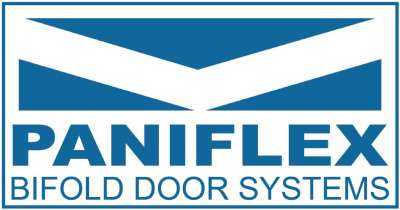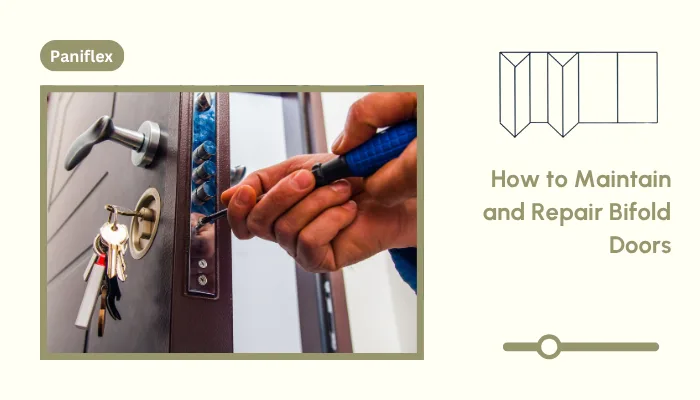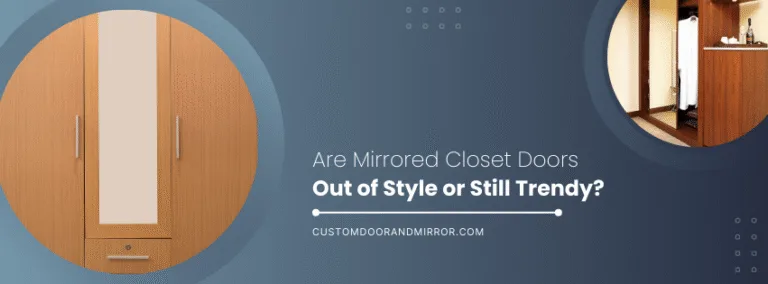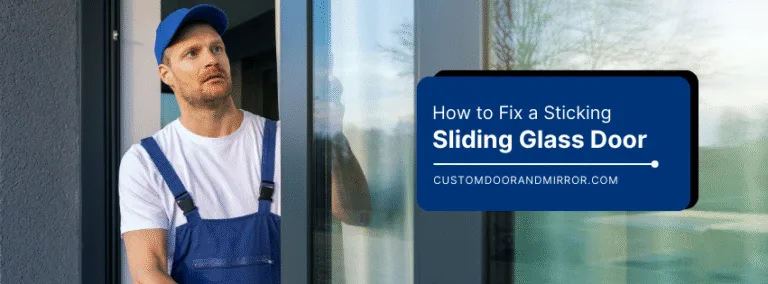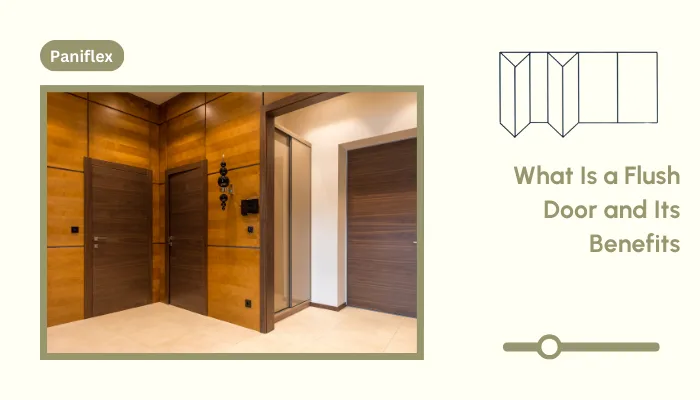Bifold doors are a popular choice in both commercial and residential spaces thanks to their space-saving design and modern look. However, like any moving part, they require regular maintenance to operate smoothly and avoid common problems such as sticking doors, misalignment, or worn-out hardware.
We understand how frustrating it can be when a bifold door fails in a busy environment, disrupting both functionality and appearance. This guide offers practical tips for maintaining bifold doors, troubleshooting common issues, and knowing when to seek professional help.
Ready to experience the benefits of custom closet doors? Explore our range of Paniflex products now.
TL;DR
- Regular maintenance, such as cleaning tracks, lubricating hardware, and checking alignment, keeps bifold doors operating smoothly and prevents costly repairs.
- Common issues include sticking, misaligned panels, worn rollers, and loose hinges, often caused by wear or environmental factors.
- Some problems require professional repair or complete replacement, especially when structural damage or outdated hardware affects performance.
- Choosing quality materials and hardware, paired with preventive care, extends the lifespan of bifold doors in both residential and commercial spaces.
Understanding How Bifold Doors Work
Bifold doors are designed with two or more panels connected by hinges, which fold together as they slide along a track system. This mechanism enables them to open wide without occupying much floor space, making them ideal for closets, room dividers, and even commercial spaces where space efficiency is crucial.
The panels are guided by pivot brackets and rollers, ensuring smooth movement and proper alignment. Each component plays a critical role in the door’s performance. When any of these parts become loose, misaligned, or worn, it can affect the door’s operation and create unnecessary strain on other components.
Recognizing how bifold doors function makes it easier to spot problems early. Let’s examine some of the most common issues that can affect bifold doors and how they develop over time.
Suggested Read: How to Fix a Large Gap Under the Door?
Common Issues with Bifold Doors
Even well-installed bifold doors can develop issues over time, particularly in high-traffic areas or environments with significant humidity and temperature fluctuations. Understanding these common issues helps you address them early and keep the doors functioning properly.
- Sticking or dragging: This usually happens when dirt and debris accumulate in the tracks or when panels swell due to humidity. Left unchecked, it can cause damage to the track and put extra strain on the rollers.
- Loose or squeaky hinges: Frequent use can loosen hinge screws over time, leading to wobbly panels or annoying squeaks during operation. Regular tightening can prevent further wear.
- Misaligned panels: Misalignment often results from worn pivot brackets, sagging panels, or improper installation. It affects smooth operation and may cause panels to bind or come off the track.
- Damaged or worn tracks and rollers: Continuous sliding motion wears down these components, causing jerky movement or doors popping out of alignment. Replacement may be needed for heavily used doors.
- Warped panels or surface damage: Environmental factors, such as moisture or impact from heavy use, can warp door panels or cause visible dents and scratches, compromising both function and appearance.
Resolving these issues starts with having the right tools and materials readily available. The next section outlines everything you will need to maintain and repair bifold doors effectively.
From the Community: Read more about fixing a bifold door that collapsed at the bottom pivot point in this Reddit thread.
Tools and Materials Needed for Maintenance and Repair
Proper maintenance and repair of bifold doors require more than just basic DIY skills—you also need the right tools and materials to ensure the job is done safely and effectively. Having these essentials ready can save time and prevent further damage to the door system.
| Tool/Material | Use |
|---|---|
| Screwdriver Set | Tightening or loosening hinges, brackets, and hardware screws. |
| Allen Wrench (Hex Key) | Adjusting pivot brackets and hardware alignment. |
| Silicone Spray Lubricant | Reducing friction on tracks and rollers for smoother operation. |
| Level | Ensure panels and tracks are properly aligned during repair. |
| Replacement Rollers/Tracks | Swapping out worn or damaged components for seamless movement. |
| Cleaning Brush/Cloth | Removing dirt and debris from tracks and hardware. |
| Wood Filler or Epoxy | Repairing minor dents, chips, or surface damage on panels. |
| Measuring Tape | Verifying dimensions when adjusting or replacing door parts. |
With the right tools and materials in place, maintaining bifold doors becomes a straightforward task. The next section outlines regular maintenance tips to keep your bifold doors operating smoothly and extend their lifespan.
Suggested Read: How to Install Bifold Door Snugger: A Basic Guide
Regular Maintenance Tips for Bifold Doors
Routine maintenance is key to preventing common bifold door issues and ensuring they continue to operate smoothly. A simple maintenance schedule can save you time, reduce repair costs, and prolong the lifespan of doors in both residential and commercial settings.
1. Clean the Tracks Regularly
Dirt and debris in the tracks are the most common causes of sticking and dragging. Use a soft brush or vacuum to remove buildup, then wipe the surface with a damp cloth for a clean finish.
2. Lubricate Moving Parts
Apply a silicone-based lubricant to the tracks, rollers, and pivot points to minimize friction and ensure smooth folding and sliding. Avoid using oil-based lubricants, which can attract more dust.
3. Tighten Hinges and Hardware
Over time, screws and brackets can loosen due to frequent use. Check all hinges and hardware periodically, tightening them as needed to prevent wobbling panels and misalignment.
4. Inspect Rollers and Pivot Brackets
Inspect these components for signs of wear or damage. Replacing worn rollers or pivot brackets early can prevent doors from coming off the track.
5. Check Panel Alignment
Ensure the door panels hang straight and fold evenly. Misaligned panels can indicate issues with the pivots or tracks that need adjustment.
6. Protect Against Moisture Damage
In humid environments, regularly check for swelling or warping of wooden panels. Consider using moisture-resistant finishes or materials for added durability.
Even with regular maintenance, bifold doors may sometimes require repairs. The following section provides a step-by-step guide to tackling everyday repair tasks and restoring proper function.
Step-by-Step Guide to Repairing Bifold Doors
Even with regular upkeep, bifold doors can sometimes develop issues that require hands-on repairs. Whether it is realigning panels, fixing loose hardware, or replacing worn-out components, these step-by-step instructions will help you address common problems safely and effectively.
- Remove the Door Panels (if necessary): Lift the panels slightly to release them from the bottom pivot bracket, then tilt them out of the track. This provides full access to tracks, rollers, and hardware for inspection or replacement.
- Inspect Tracks and Rollers: Look for dirt, dents, or wear on tracks and rollers. Clean tracks thoroughly and replace any rollers that appear cracked, flattened, or no longer glide smoothly.
- Adjust Pivot Brackets: Loosen the screws on the top and bottom pivot brackets slightly. Adjust the brackets to align the panels correctly, ensuring they are level and fold evenly. Retighten the screws securely once the alignment is correct.
- Tighten or Replace Hardware: Check all hinges, brackets, and screws for looseness. Tighten them as needed. Replace any stripped screws or worn-out brackets to restore stability.
- Reinstall Door Panels: Place the top pivot pin into the track, then align and set the bottom pivot into the bracket. Ensure the panels are correctly seated and test for smooth folding and sliding.
- Test and Fine-Tune: Open and close the doors several times to check for smooth operation. Make minor adjustments to pivots or tracks as needed until the doors operate without resistance or misalignment.
Before starting any repair work, it is important to consider safety. The following section highlights essential precautions to take when repairing bifold doors to avoid accidents and ensure a secure installation.
Suggested Watch: Find the easiest ways of repairing a bifold door in this video.
Safety Considerations During Bifold Door Repairs
Repairing bifold doors involves handling panels, hardware, and tools that can pose risks if not approached carefully. Prioritizing safety helps prevent injuries and protects the door system from further damage during the repair process.
Safety Tips to Keep in Mind:
- Use protective gear: Wear gloves to protect hands from sharp edges and safety glasses when working near hardware or drilling.
- Support door panels properly: When removing or reinstalling panels, have a second person assist to prevent the panels from tipping or falling.
- Disconnect any automated mechanisms: For bifold doors with automatic systems, turn off power to avoid accidental movement during repairs.
- Secure the work area: Clear obstacles around the door and ensure stable footing when using ladders or step stools.
- Handle tools with care: Use the correct tools for each task and follow manufacturer guidelines for hardware adjustments or replacements.
In some cases, repairs may no longer be enough to restore a bifold door’s function or appearance. The following section will help you identify the signs that indicate it’s time to replace the doors instead of continuing with repairs.
Suggested Read: Guide To Sizing A Rough Opening For Bifold Doors
Signs It’s Time to Replace Instead of Repair
While many issues with bifold doors can be resolved, there are situations where replacement is the more cost-effective and smarter choice. Knowing when to recommend a new door helps you save your client from repeated repairs and frustration.
These are some situations when you should advise your client to replace their door rather than repair it.
- Severely warped or cracked panels: Structural damage often cannot be restored without compromising strength or appearance.
- Extensive hardware failure: When multiple components, such as tracks, rollers, and pivots, are worn out, replacement is more practical than sourcing numerous individual parts.
- Outdated design or materials: Clients may prefer upgrading to modern, more durable options that better suit their space.
- Repeated alignment issues: Frequent misalignment may indicate underlying problems with the frame or structure that repairs cannot resolve.
- Visible surface damage: Deep scratches, dents, or water damage that affects the door’s finish or core integrity often calls for a fresh installation.
Replacing a door is sometimes unavoidable, but consistent preventive care can significantly extend the life of bifold doors and reduce the need for major interventions. The following section covers key steps to help your clients protect their investments.
Preventive Care to Extend Lifespan
Bifold doors, like any moving architectural element, benefit significantly from preventive care. Regular attention not only ensures smooth operation but also helps avoid costly repairs and replacements down the line. This is an important consideration for professionals managing high-traffic commercial or design-sensitive residential spaces.
Simple preventive practices include:
- Establish a routine inspection schedule: Check doors quarterly for loose hardware, alignment issues, and signs of wear, especially in commercial settings.
- Clean and lubricate tracks regularly: Dust and debris buildup are leading causes of operational problems; pair cleaning with silicone-based lubrication.
- Educate clients on gentle use: Encourage users to avoid slamming or forcing panels, which can damage hinges and pivots.
- Seal and protect surfaces: In humid or outdoor environments, apply moisture-resistant finishes to wooden panels to prevent warping.
- Upgrade hardware as needed: Recommend higher-grade rollers and pivots in areas with heavy daily use to extend the door’s life.
Preventive care works best when paired with quality components. The next section explains why choosing durable hardware and materials is critical to the longevity and performance of bifold doors.
Choosing Quality Hardware and Materials for Bifold Doors
The longevity and performance of bifold doors are directly tied to the quality of their hardware and materials. Low-grade components may initially save costs, but they often lead to frequent repairs, misalignment issues, and premature wear, particularly in commercial or high-traffic environments. Opting for durable tracks, heavy-duty rollers, and corrosion-resistant hinges ensures smoother operation and reduces long-term maintenance needs.
Material choice also plays a critical role. Solid wood panels offer a timeless appearance but require proper sealing in humid areas, while engineered materials or aluminum frames provide greater resilience in demanding settings. For designers and contractors, specifying premium finishes and robust hardware aligns functionality with the desired visual impact of the space.
When your project requires precision, durability, and customized solutions, partnering with a trusted manufacturer can make all the difference. This is where Custom Door & Mirror comes in, offering expertly crafted bifold doors built to meet your exact specifications.
Custom Door & Mirror Offers Superior Bifold Door Solutions
When it comes to bifold doors that strike a balance between designer appeal, functionality, and long-term durability, Custom Door & Mirror stands out as a trusted partner for professionals. Their expertise in crafting precision-fit doors ensures seamless integration in both residential and commercial projects.
Key Features of Custom Door & Mirror’s Bifold Doors:
- True to Fit Engineering: Designed to accommodate uneven walls and non-standard openings for a flawless installation every time.
- Premium Materials and Finishes: Options include mirrored panels, solid wood, and engineered materials, all tailored to meet client preferences.
- Heavy-Duty Hardware: High-quality tracks, rollers, and pivots built for smooth, long-lasting performance even in high-traffic areas.
- Custom Design Capabilities: Create bifold doors that match the designer’s vision of any space, from modern minimalism to classic styles.
- Professional Support: Dedicated guidance for architects, contractors, and designers to simplify specification and installation.
Whether your project requires standard or fully customized bifold doors, Custom Door & Mirror provides the precision and quality that professionals demand. Their commitment to craftsmanship and client support makes them an ideal choice for projects of any scale.
Ready to experience the benefits of custom closet doors? Explore our range of Paniflex products now.
Conclusion
Maintaining and repairing bifold doors does not have to be complicated when you understand their mechanics and follow a consistent care routine. From preventive maintenance to knowing when replacement is necessary, taking a proactive approach ensures smooth operation and extends the lifespan of these space-saving solutions.
For projects that demand precision and high-quality results, Custom Door & Mirror offers expertly crafted bifold doors designed to meet both functional and design requirements. Their tailored solutions and durable hardware make them a trusted partner for architects, contractors, and interior designers.
Ready to improve your next project? Contact us today to explore custom-made bifold door solutions built to last.
Frequently Asked Questions
- What are the common problems with bifold doors?
Common issues include sticking or dragging panels, misaligned tracks, loose or squeaky hinges, and worn-out rollers or pivot brackets. Environmental factors, such as humidity, can also cause warping or swelling of wooden panels, which can affect smooth operation over time.
- What is the best lubricant for bifold doors?
A silicone-based spray lubricant is ideal for bifold doors. It reduces friction on tracks and rollers without attracting dust or debris. Avoid oil-based lubricants, as they can clog and lead to more frequent maintenance issues.
- Do bifold doors need servicing?
Yes, regular servicing helps ensure smooth operation and extends their lifespan. Simple tasks, such as cleaning tracks, lubricating moving parts, tightening hardware, and inspecting for wear, can prevent costly repairs and keep bifold doors functioning efficiently.
- What is the life expectancy of a bifold door?
With proper maintenance, bifold doors can last 15 to 20 years or more. Their lifespan depends on usage frequency, material quality, and environmental conditions. High-quality hardware and preventive care significantly increase durability in both residential and commercial settings.
